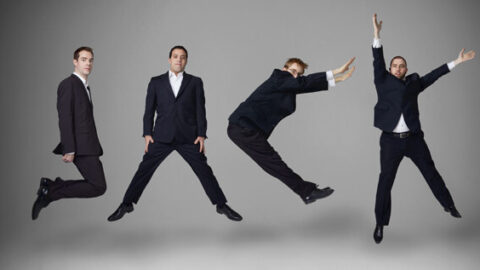 The Cleveland Contemporary Players series, founded by composer and Cleveland State University professor Andrew Rindfleisch, presented the JACK Quartet in a varied program of music beginning with a work from 1400 and ending with a World Premiere on September 16, 2013. The JACK (acronymically named for the members – violist John Pickford Richards, violinist Ari Streisfeld, violinist Christopher Otto, and cellist Kevin McFarland) is also part of the Artist-in-Residency Series at Cleveland State, interacting with students in workshops, master classes, and playing composition students’ music. The organizing principle of the JACK’s program was the unorthodox sounds that arise in music from unusual tuning systems, muting, and natural harmonics.
The Cleveland Contemporary Players series, founded by composer and Cleveland State University professor Andrew Rindfleisch, presented the JACK Quartet in a varied program of music beginning with a work from 1400 and ending with a World Premiere on September 16, 2013. The JACK (acronymically named for the members – violist John Pickford Richards, violinist Ari Streisfeld, violinist Christopher Otto, and cellist Kevin McFarland) is also part of the Artist-in-Residency Series at Cleveland State, interacting with students in workshops, master classes, and playing composition students’ music. The organizing principle of the JACK’s program was the unorthodox sounds that arise in music from unusual tuning systems, muting, and natural harmonics.

The highlight of the evening was the World Premiere of String Quartet No. 2, a commission for the JACKs from Rindfleisch himself. This 30 minute piece unfolds in four movements – I. Violently intense, relentless; II. Elegant, with ease; III. Expressive, distant; and IV. Ethereal, ghostly, spiritual. The score calls for scordatura tuning with one string on each instrument tuned a quarter note up or down, resulting in an eerie, off-kilter soundscape. Mutes of various types and sizes were also used throughout the piece, further contributing unexpected tones and timbres.
The first movement, as the marking indicates, was extremely intense and relentless. The players attacked their instruments with fiery zeal, aggressive bowing, and abrupt stops and starts. The driving pace eased occasionally only to return with increasing vigor. Occasional moments of melody and harmony were overwhelmed by the dominant mood of ferocity. The following movements explored the aftermath of the unrelenting violence of the first, like slowly fraying gossamer turning into dust. The second movement opened with light, airy figures, the bows barely touching the strings. A cello melody was interspersed with sounds of fear and anxiety from the other players. The highlight of the third movement was an enthralling cello solo with notes so high that McFarland’s left hand was well below the fingerboard, pinching and holding the strings to achieve the effect. The end evoked a sense of pained resignation, as in the finale of Messiaen’s Quartet for the End of Time. Quiet, thoughtful, and reflective, the music celebrated the resilience of “the self,” even in the face of devastation, with bell-like tones in the cello and whispering harmonics from the violins and viola.

The program opened with Angelorum Psalat from the Chantilly Codex attributed to Rodericus circa 1400, arranged for string quartet by Otto. Despite its origin in the Renaissance, the harmonic and rhythmic complexity of the piece felt fresh and contemporary. Built of overlapping lines with shifting duos playing pizzicato vs. bowing, the music swayed in and out of dissonance. If program notes had not been available indicating the date, one might have been confused about its origin.
Plainsound String Quartet “Holy Howl” (2013) by Wolfgang von Schweinitz explores the use of microtonal just intonation tuning systems common in ancient musical performances before the advent of equal temperament tuning most commonly used today. The first section opened by slowly unfurling broad luscious melodies. A multitude of eerie overtones unleashed by the just interval tuning pushed the sound to the borders of consonance and gave the piece a staggering rhythmic quality. At moments the sound texture was reminiscent of Pauline Oliveros playing her just-intonation accordion. In the second section, each member of the quartet laid out unique but related melodies at a drunken-andante pace. A barrage of overtones set off vibrations that hit the listener’s ears in unexpected ways and resonated through the whole body, a sort of transportive energy field that was pleasantly disorienting. The cello led the finale, full of the wolf-like howl sounds indicated in the title, a reference to Allen Ginsberg’s rhapsodic Footnote to Howl. With mutes applied, the music turned dark and foreboding and the overtones took on an ominous edge. The cello and viola combined to sound like a harmonium, an instrument Ginsberg was fond of playing when reciting his poetry. The overall effect was that of an abstract elegy for Carl Solomon, to whom Ginsberg’s poem was dedicated.

John Zorn’s The Dead Man (1990) was like 13 short theme songs for madcap cartoon episodes, inspired by the book of the same name by French philosopher Georges Bataille. The music moved frenetically, as the JACKs employed one zany way of using a bow on strings after another. There was plenty of screeching, groveling, and crunching, with occasional melodies unleashed in this very fast paced piece. Other interesting techniques involved leaning the bow very hard on the strings and then twisting it in various directions to create a special kind of screech. The musicians were also required to use their hands and arms in unusual ways. In one movement, they waved their hands about as if shooing insects away or trying to swat them. This brief and spirited piece provided a welcome bit of comic relief, despite its deep philosophical origins.
























